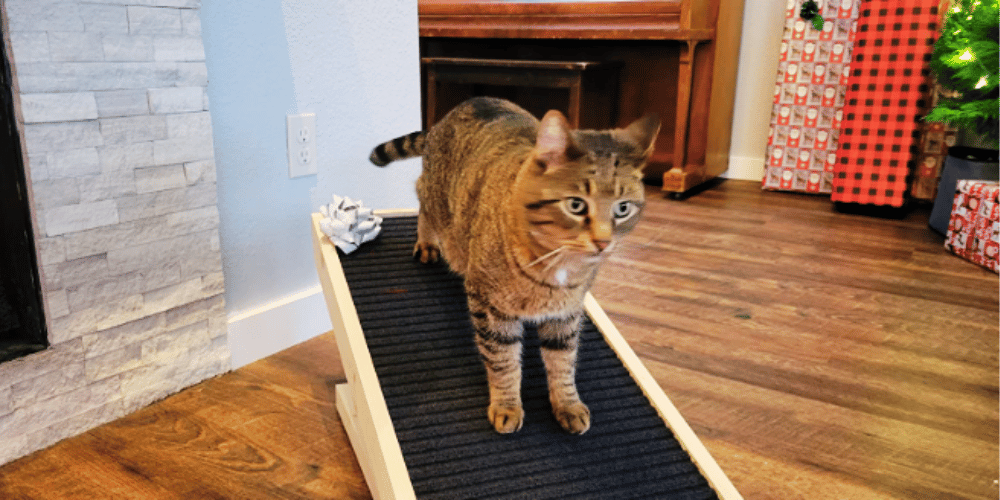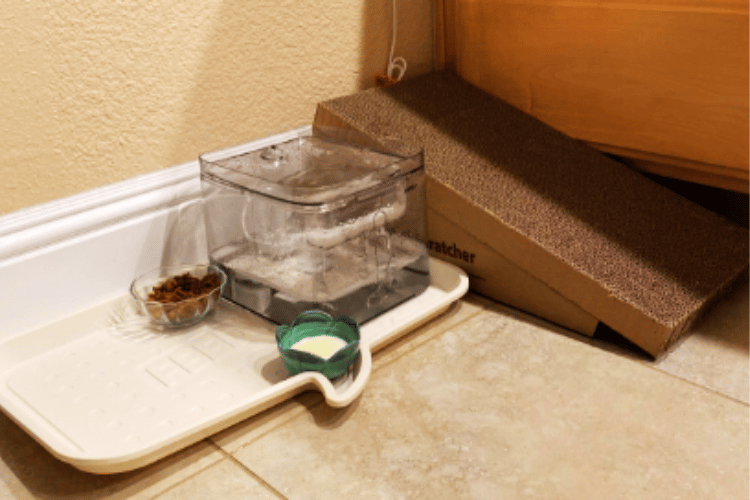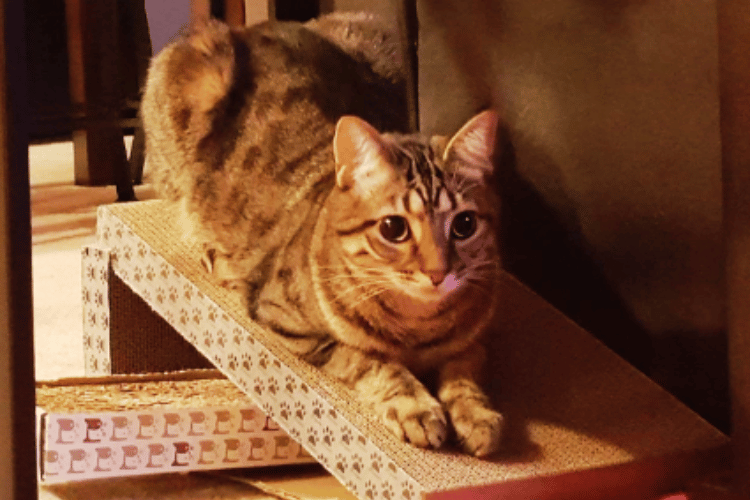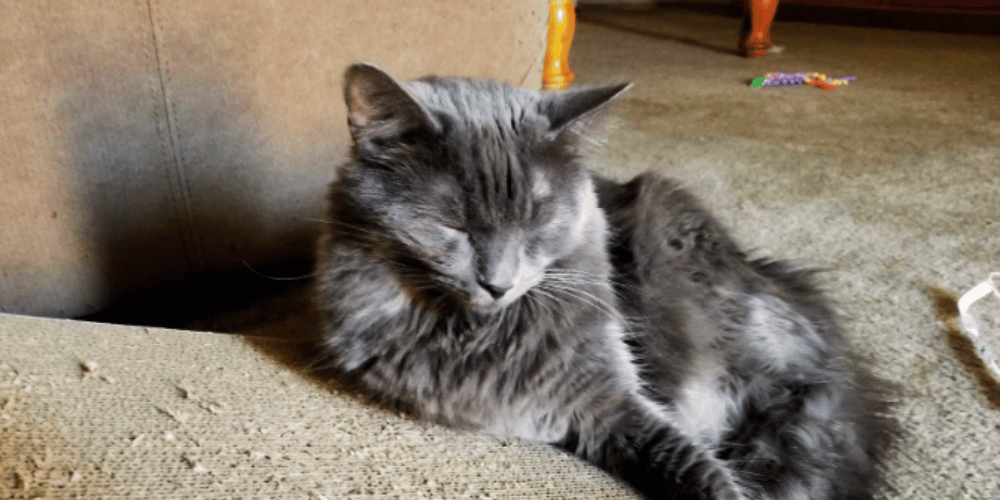Cats are agile creatures, often surprising us with their ability to jump and climb to great heights. However, there are times when a ramp can be a safer and more comfortable option for our feline friends, especially for a senior pet or one with mobility issues. Training your cat to use a ramp can enhance their well-being and ensure they can still enjoy their favorite spots without the risk of injury.
Key Takeaways:
- Training a cat to use a ramp involves patience, positive reinforcement, and a gradual approach.
- The correct pet ramp should be chosen based on the pet's size, the intended use, and it should have a textured surface for better grip.
- Consistency and creating a positive association with the ramp are crucial for successful ramp training.

Choosing the Right Ramp
Before you begin training your cat to use a ramp, it's essential to select the correct pet ramp. Several factors should be considered, such as the pet's size, the height of the furniture or vehicle, and the ramp's stability. Ensure the ramp has a textured surface to prevent slipping and is long enough to provide a gradual incline. This will make the entire ramp less intimidating and more comfortable for your furry friend to use.
Introducing the Ramp
Introduce the ramp to your cat in a familiar environment where they feel safe. Start with the ramp flat on the ground to let your pet inspect it at their own pace. Encourage exploration by placing treats or toys along the ramp. Praise your cat and offer rewards when they show interest or walk on the ramp. This positive association is the foundation of successful ramp training.
Creating a Positive Experience
Positive reinforcement techniques are key when teaching your cat to use a new ramp. Use treats, praise, and their favorite toys to encourage and reward any interaction with the ramp. The goal is to create a positive experience, so your pet associates the ramp with good things. Be patient and avoid rushing the process, as this can lead to anxiety and reluctance.

Gradual Introduction to Incline
Once your cat is comfortable with the ramp on flat ground, it's time to gradually increase the incline. Start with a slight incline and let your pet learn to walk up and down at this new angle. Continue to use treats and praise to reinforce positive behavior. If your cat seems hesitant, take a step back and reduce the incline until they're confident again.
Building Confidence
Building your pet's confidence is crucial for them to feel comfortable using the ramp. Encourage them to walk the entire ramp by leading with treats or a toy. If they fall or seem unsure, gently guide them back onto the ramp and reassure them with a calm voice and gentle petting. Remember, confidence comes with time and practice.
Training Tips and Tricks
Training your cat to use a ramp may require some creative tricks. If your cat enjoys chasing a laser pointer or a feather wand, use these toys to lead them up and down the ramp. Always end on a positive note, with lots of praise and a few extra treats to reinforce the behavior.

Understanding Your Pet's Capabilities
When training your pet to use a ramp, it's essential to consider your pet's size and physical abilities. Larger pets may require a sturdier ramp, while smaller pets might need a ramp with a gentler slope. Observe how your pet moves on a daily basis—do they have difficulty with stairs or jumping onto furniture? This can give you insight into the type of ramp that will best suit their needs. For pets with shorter legs or those in their senior years, pet steps with a gradual incline can make a significant difference in their quality of life.
Moreover, it's important to notice any signs of hesitation or discomfort as your pet approaches the ramp. This could indicate that the ramp's incline is too steep or that your pet is unsure about using it. Adjusting the ramp gradually to find the perfect angle can help build your pet's confidence. Remember, each pet is unique, and what works for one may not work for another. Tailoring the ramp experience to your pet's individual capabilities will ensure they feel secure and comfortable during use.
Incorporating Fun into Training
Training your pet to use a ramp should be an enjoyable experience for both the pet and the owner. One way to teach your pet to use the ramp is by turning it into a game. Place their favorite treat at various points along the ramp to encourage them to walk up and down. This method of rewarding will not only entice them to use the ramp but also associate it with positive outcomes. Over time, your pet will start to look forward to ramp time, knowing that it leads to treats and praise.

Additionally, consider putting your pet's favorite toy at the top of the ramp or playing a game of fetch that incorporates the ramp as an obstacle. This can help your pet to associate the ramp with playtime, further reinforcing its use in a fun and engaging way. The key is to make the ramp an integral part of your pet's life, so they view it as just another aspect of their daily routine. With consistent practice and a bit of creativity, your pet will be navigating the ramp with ease and enjoyment.
Safety First
Ensure the ramp is stable and secure before encouraging your cat to use it. Check for any wobbly parts or slippery surfaces that could cause your pet to fall. Consider using a harness and lead for extra security during the initial stages of ramp training. Safety should always be your top priority.
Adjusting to Different Heights
Once your cat is confident using the ramp at a slight incline, you can gradually increase the height to match the bed, couch, or car. Make sure there's enough room at the top and bottom of the ramp for your cat to land comfortably. This adjustment period is crucial for helping your pet understand that the ramp can be used in various situations.

Overcoming Obstacles
If your cat is hesitant to use the ramp to climb onto higher furniture, place their favorite blanket or bed at the top to encourage them. Sometimes, making the destination more appealing can help overcome any reluctance. Be patient and give your pet extra time to adjust to the new height.
Consistency is Key
Consistency in training will help your cat learn faster. Practice using the ramp several times a day, gradually increasing the difficulty as your pet becomes more confident. Stick to a routine to help your cat understand what's expected of them and to reinforce the training.
When to Use a Verbal Cue
As your cat becomes more adept at using the ramp, you can introduce a verbal cue such as "ramp" or "climb." Use this cue every time your cat approaches the ramp to create a consistent command that prompts them to use it. Over time, this cue will help your cat understand when and where to use the ramp.
Recognizing Your Pet's Limitations
Be mindful of your pet's limitations. If your cat has severe mobility issues or is particularly anxious, they may require more time to get used to the ramp. Never force your cat to use the ramp if they're visibly distressed. Instead, take a break and try again later, always moving at your pet's pace.

Celebrating Success
When your cat successfully uses the ramp, make a big deal out of it! Offer plenty of praise, treats, and affection to let them know they've done well. Celebrating these small victories will boost your pet's confidence and encourage them to keep using the ramp.
Summary
Training a cat to use a ramp requires selecting the right size and type of ramp, introducing it on flat ground, and using positive reinforcement to create a good association. Gradually increase the incline and ensure the ramp is safe and secure. Be patient, consistent, and mindful of your pet's limitations, and celebrate every success to build confidence.
FAQ Section
Q: How long does it take to train a cat to use a ramp? A: The time it takes to train a cat to use a ramp can vary greatly depending on the individual cat's personality, age, and mobility. Some cats may take to it within a few days, while others may need several weeks of consistent training.
Q: Can you train older cats to use a ramp? A: Yes, older cats can be trained to use a ramp. In fact, ramps can be particularly beneficial for senior pets with mobility issues. The key is to be extra patient and gentle during the training process.
Q: What if my cat is afraid of the ramp? A: If your cat is afraid of the ramp, go back to the basics. Start with the ramp flat on the ground and use treats and toys to create positive associations. Move at your cat's own pace and never force them to use the ramp if they're not ready.
Thank you for visiting LegitLists we hope this helps you make a legitimate choice!






